
scrounge: /skrounj/ informal verb: to actively seek [books] from any available source
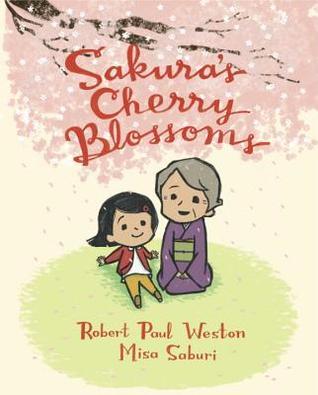
Sakura's Cherry Blossoms is a sweet story about a girl who has to leave her home in Japan, including her grandmother. She and her grandmother used to sit together and eat under a cherry tree as it blossomed, and in America she does not see any cherry trees. Learning English and making friends are difficult things that she has to navigate in this new place.
The story touches on feelings of loss, not just of place, but of people we love (it doesn't specifically mention that Sakura's grandmother dies, but she does go back to visit her one last time to say goodbye, so it is assumed).
In the end, Sakura is sad but makes a friend, and learns to find things in her new home that help her remind her of her grandmother -- especially when spring comes and she realizes that some places in the US have cherry trees too!
The last page of the book explains that this story is written entirely in the "tanka" style of Japanese poetry, which is similar to haiku but includes two longer lines at the end as well. The phrasing and structure of some of the lines made more sense to me after this.
(In compliance with FTC guidelines, I disclose that I received this book for free through LibraryThing Early Reviewers. I was not required to write a positive review.)
Scrounged From: A LibraryThing giveaway
Format: Hardcover
Author: Robert Paul Weston
Illustrator: Misa Saburi
Pages: 40
Content Advisory: Sakura misses her grandmother and expresses sadness about leaving her (death is not explicitly mentioned, but illness is).
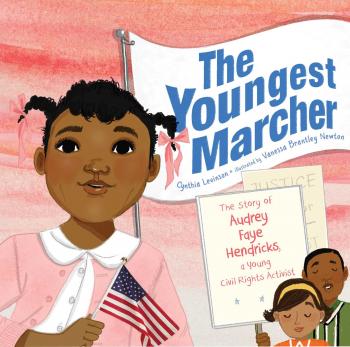
The Youngest Marcher is a story of a girl I'd never heard of before -- Audrey Faye Hendricks, who at nine years old was the youngest known marcher to go to jail for protesting segregation during the Civil Rights Movement.
I thought this book did a good job of balancing its tone between serious and lighthearted. Reading about a young girl being kept for a week in a dirty jail cell is sad and disturbing, but also important. But the story keeps its eye on the prize, and focuses on young Audrey's determination, sense of justice and, at the end, pride at having helped to accomplish the removal of segregation laws.
She was fortunate in that Martin Luther King, Jr. was a family friend who ate at their table and spoke at their church. He said that an "unjust law is no law at all," and called on people to fill the jails in protest. When there weren't enough people filling the jails, he declared that they should fill the jails with children, and that is what happened.
I think this book has potential to communicate the before-and-after picture of segregation very well, in a way that children can understand. Of course, parents/teachers should use discretion as to children's age/maturity levels, but I think Audrey Hendricks' ability to put a child's face on the Civil Rights Movement is very important.
Scrounged From: Our local library
Format: Hardcover
Author: Cynthia Levinson
Illustrator: Vanessa Brantley Newton
Pages: 40
Content Advisory: As mentioned, a little girl spends a week in jail, and protestors describe being sprayed by water hoses and chased by the KKK.
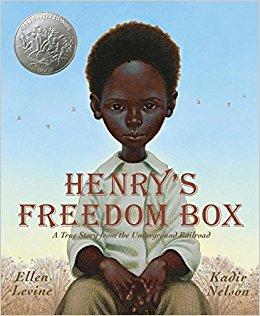
Henry's Freedom Box is the true story of Henry "Box" Brown, an enslaved man who mailed himself to freedom in 1849. This telling of that story is both devastating and triumphant, and as usual, Kadir Nelson's illustrations capture every emotion and event perfectly.
Henry grew up with a master who seemed to treat him well, relatively speaking. But then he was given to his master's son and sent to work in a tobacco factory. After he married and had three children, Henry's wife and children were sold away from him (this scene might be difficult for sensitive readers.)
Henry's method of gaining his freedom leads him into a wooden box which is carried on carts and a boat, and includes some rough handling, but it works. This book did a great job of breathing life into a story I'd heard before only in a vague and generalized sense, and gives the name and details to go with it.
Scrounged From: Our local library
Format: Hardcover
Author: Ellen Levine
Illustrator: Kadir Nelson
Pages: 40
Content Advisory: Henry's wife and children are sold away from him around the middle of the story.
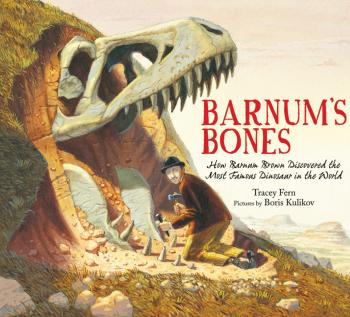
Barnum's Bones was a really neat story of a historical figure I'd never heard of before. Since my five-year-old is a dinosaur enthusiast, we both enjoyed this story about the man who discovered the first documented Tyrannosaurus skeleton.
Barnum Brown seems an almost larger-than-life figure as his obsession with fossils compels him to attend school, become a paleontologist, and spend his life searching all over the world for as many fossils as he can "sniff out." But what he really wants is to discover something new -- something that will make the American Museum of Natural History proud.
While it doesn't happen immediately (and the process is especially slow since it was limited to turn-of-the-twentieth-century technology -- horses, wagons, and trains), he does eventually discover the bottom half (ish) of a Tyrannosaurus, but it is several years later before he gets back to a nearby spot and finally finds the enormous head. What it must have been like to be an ordinary person in those days and be astounded at these new kinds of discoveries!
Scrounged From: Our local library
Format: Hardcover
Author: Tracey Fern
Illustrator: Boris Kulikov
Pages: 36
Content Advisory: None
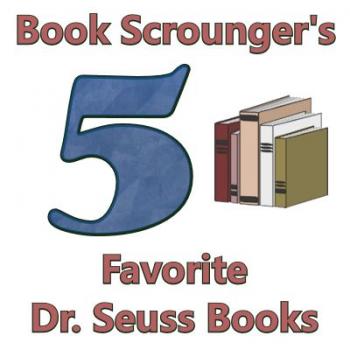
I grew up with Dr. Seuss -- I remember my mom reading me The Cat in the Hat, and I spent plenty of time reading his books to siblings, and then to my own kids. I've probably got Hop on Pop memorized, and can do a pretty fast rendition of Fox in Socks by now.
Coming up with my top 5 Dr. Seuss books was hard, but I did my best. Here they are, starting with 5:
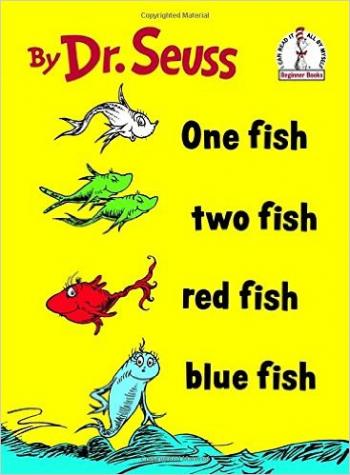
5. One Fish, Two Fish, Red Fish, Blue Fish is one of the "beginnger books" that I grew up with. But I don't believe we ever owned it, so I didn't come to know it forwards and backwards like some of the others -- I think that added to its appeal. This book is basically a celebration of weird creatures that Dr. Seuss has invented, explained by the tagline "From there to here, from here to there, funny things are everywhere." It features such favorites as the Yink who drinks pink ink, the Zans for cans, the Yop who likes to hop, as well as other memorable inventions that remain unnamed.
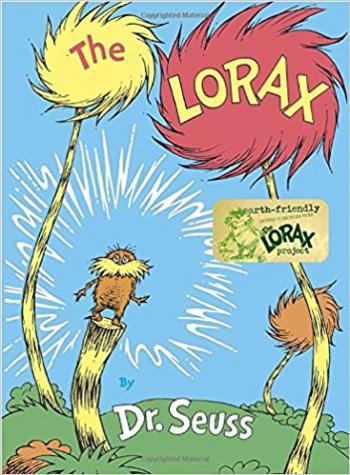
4. The Lorax is one Dr. Seuss book that I didn't encounter until I was an adult. I'd heard of it, of course, since it was made into a movie, and knew it had something to do with trees, but that was about it. The story speaks fairly bluntly to our materialism and consumerism, and yet it doesn't feel overdone. Seuss knew how to make use of absurdity and hyperbole with just enough reality thrown in to drive his point home.
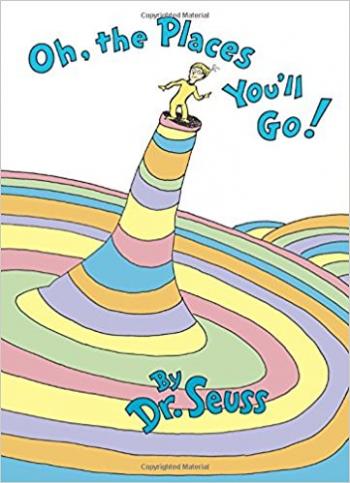
3. It's a common graduation gift, but Oh, the Places You'll Go! is another that I didn't read until adulthood. It's a celebration of freedom and potential, declaring "You have brains in your head. You have feet in your shoes. You can steer yourself any direction you choose." It promotes self-determination, persistence, and courage, while also giving encouragement for the difficult, lonely, and confusing times of life (because they will come). I think it still has a lot to say to those of us who are long out of college, and in such creative, evocative, and sometimes absurd ways.
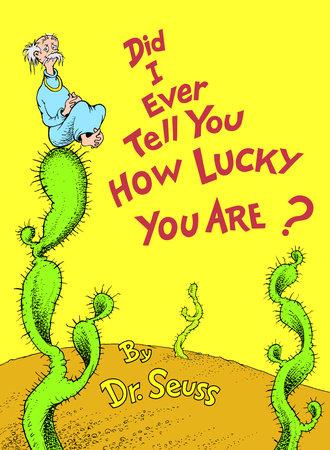
2. I'm pretty sure Did I Ever Tell You How Lucky You Are? was the first Dr. Seuss book I ever personally owned, so it holds a special place in my heart. My copy is falling apart now, but I still don't have the heart to throw it in the recycling bin. It's full of wacky, absurd situations (some of them quite intricately illustrated) in which someone is stuck in a difficult position (though often humorously so), which is then used to point out that some people are "ever so muchly much much more unlucky than you." Some may see this as being dismissive, but I think this is far too silly and crazy to be taken that seriously. I think it was just a way for Dr. Seuss to make up a whole bunch of weird scenarios for the fun of it. I also never knew it was possible to feel bad for a coat hanger.
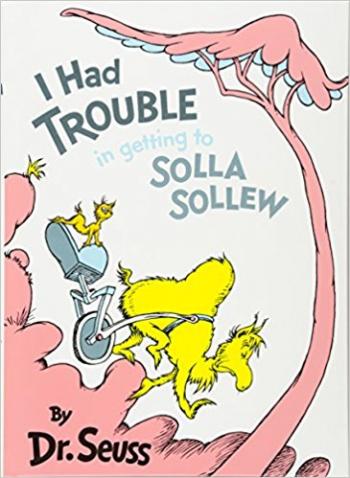
1. I Had Trouble in Getting to Solla Sollew is my all-time favorite Dr. Seuss book, hands down. It's the story of a... well... a Seussical creature who lives in a place where he's constantly getting attacked by other Seussical creatures with strange names. But then he hears the tale of a place called Solla Sollew, "where they never have troubles, at least very few." So off he goes in search of this Seussian utopia, but he finds the journey to be anything but easy. After many detours and setbacks, he finally arrives at his destination, and finds that there's only one tiny trouble -- but it prevents him from getting in. The message I took from the story is that you can't run away from your troubles -- in the end, he learns to face them. As a kid, while I appreciated the ending, it also gave me this sad feeling -- like, I really wanted to see what was inside Solla Sollew. It looked so amazing. It was like realizing utopia isn't real, which I guess is just the kind of let-down we all need at some point. But sometimes I would still have dreams about it, like the Seussical creature did -- what would it be like to fall asleep on a pile of marshmallow-stuffed pillows? Probably we don't have to invent utopia to find out.
Of course, there are others. I also really like How the Grinch Stole Christmas! (review here), Oh, the Thinks You Can Think!, and If I Ran the Circus!, among others. But I decided five was all I could try and rank for now -- more would be too difficult!


